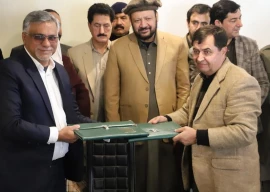
Pakistan dumps 99% raw municipal sewage and industrial effluent into sea and other water bodies. The country’s once functional sewage treatment plants in Karachi, Islamabad, Lahore and Faisalabad have been largely rendered dysfunctional by encroachments, stolen machinery, ghost staff, lack of maintenance and misgovernance. Sinking in one’s own sewage may best describe our existing environmental status.
What makes a cleanliness-advocating nation so monumentally clueless about managing the pollution of its own making? Clearly, the existing system, driven by contractual kickbacks, lust for foreign loans and a dysfunctional bureaucracy has created a ‘cesspool’ that is deepening by the day. The proposed S-III sewage treatment project that began its life with a budget of Rs8 billion in 2007 has already crossed Rs45 billion mark — with no respite at the end of the tunnel. This article is intended to suggest that Pakistan too can treat 100% of its sewage if it is willing to adopt ingenious ways of thought and action. The proposal calls for a shift from the conventional wastewater treatment plants that involve imports, large capital, kickbacks and maintenance to Constructed Wetlands (CWs) that offer a natural and low-cost alternative. CWs are environment friendly, simple to build, easy to maintain, involve little capital and use negligible energy. The proposed treatment systems are characterised by: a) no requirement for plant or machinery and hence negligible capital or maintenance cost; b) only a handful of employees to manage; c) no requirement of gas or electricity; and d) the treated water is not sent to water bodies but stored and reused for plantation, parks and industrial applications.
CWs consist of shallow ponds or channels which have been planted with aquatic plants and which rely upon natural microbial, biological, physical and chemical processes to treat wastewater. Depending on the type of system, they contain an inert porous media such as rock or gravel or sand. Numerous cities, from Chicago to Kolkata, use CWs to treat municipal wastewater, industrial effluent and agricultural drainage. Pakistan Navy too has already done some pioneering work in this field and demonstrated the efficacy of such plants at some of its installations.
Pakistan has the wherewithal to establish hundreds if not thousands of CWs using its own resources, people, plants and pebbles. A recent research study ‘Exploring Sustainable Solution for Wastewater Treatment: A case of Lyari River’, conducted at the Karachi’s NED University describes how 150 MGD can be treated at Lyari river by making 50 CW modules, each consisting of 10 wetland cells. Built on an area of 13 acres, each CW module would also include a recreational area, an urban forest and a lake for storage of treated water. Similar modules can be built on Malir river and other streams of waste water. All this can be done with just about one tenth of the annual maintenance expense of the KWSB.
The solution to treating and reusing Karachi’s 500 MGD sewage lies in building hundreds of constructed wetlands along Lyari and Malir river beds. They also need to be built around areas such as Mai Kolachi, Nehr-e-Khayyam and along the Sea View Road and Marine Promenade, where Karachi’s costliest and tallest buildings happily discharge their raw sewage direct to the sea. This will address not just many concerns of Pakistan Navy, Karachi Port Trust and the Karachi Fish Harbour but also stop further damage to our seas, ports, harbours, equipment and marine life. Making the suggested constructed wetlands can be accomplished at one tenth the cost of the Greater Karachi Sewerage Treatment Plan, S-III, and can be achieved in 2-3 years, entirely from our own indigenous resources. This could be the biggest and most beneficial cleanup project ever launched by Pakistan. That may also be the only way Pakistan could meet at least one of the 17 sustainable development goals adopted by UN for completion by 2030.
Published in The Express Tribune, December 1st, 2023.
Like Opinion & Editorial on Facebook, follow @ETOpEd on Twitter to receive all updates on all our daily pieces.


1725443747-0/Untitled-design-(5)1725443747-0-165x106.webp)












1731669127-0/diddy-(44)1731669127-0-270x192.webp)




1731647129-0/Untitled-design-(56)1731647129-0-270x192.webp)



COMMENTS
Comments are moderated and generally will be posted if they are on-topic and not abusive.
For more information, please see our Comments FAQ